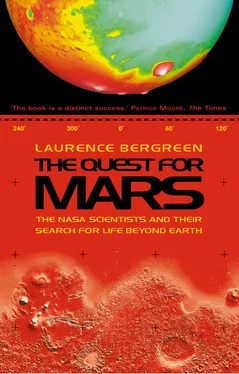Even after she arrived at JPL, Jennifer was restless. They were designing spacecraft on spec, hoping to get funding from Congress, and most projects never did. If a project actually received a green light, the lead time was awfully long. As she toiled away at her subsystems, she couldn’t see where her little cog fit into the machine, or if there even was a machine. She began to ask herself, “Is this all there is?”
She was single and didn’t have any serious ties to Pasadena or JPL. She chose to take a leave of absence, without assurance that a job would be waiting for her when she returned, if she returned. She still wanted to see the world and meet people, so she decided to do missionary work in Russia. She was assigned to Sevastapol, in the Crimea, near the Black Sea, where the conditions were unbelievably grim. There was no hot water, and they lived in cement buildings that were always cold and damp. A lot of the population were flat-out atheists. The economic situation was horrendous. She was paid about $30 a week, which made her among the wealthiest citizens of the town. Everyone around her was subsisting in a barter economy, using coupons instead of cash; one Snickers bar, for instance, cost 2,000 coupons. She and her friends based everything on the cost of a Snickers bar, but that didn’t help keep track of finances, because the inflation was incredible. Pretty soon that Snickers bar cost 8,000 coupons, then 16,000. People who had saved throughout their entire lives lost their fortunes overnight when the ruble crashed.
At times she wondered what kind of space program the Russians could possibly mount under these conditions. She had to wonder how they got anything done. As if the Russians’ pervasive fatalism wasn’t enough, there was the corruption, another thing she hadn’t been exposed to back at MIT and JPL and the family farm. She knew evil when she saw it, though, and it seemed to her that Russia, or at least her speck of it, was basically run by the Mafia, the politicians, and the church, all in bed together. After a while, she wondered if she was meant to be doing missionary work, if it was really the best use of her abilities. Was this what God wanted her to do? Was this what she wanted to do? She had to say honestly that the answer was no, her education was going to waste here. When her tour of duty was over, she left Russia to wander around Europe.
One day, she sent a postcard to a friend at JPL to say she would be back in a few months. “Do you have any jobs?” she asked, knowing the answer was very much in doubt. The day she arrived back in Ohio, JPL called to say they had a job for her, a good job, if she wanted it, but she would have to make a decision that day or the next. The job opening was on the new Pathfinder project, the next spacecraft to go to Mars. She said she’d take it. Jennifer was fairly skeptical about Pathfinder, but so was JPL. “A lot of people thought it would never work. There were so many things that could go wrong, especially with the Mars environment.” Her new job didn’t seem to have official status at JPL. Even the official Mars program people kept their distance. The development of Pathfinder struck her as a skunkworks, basically. She knew what that meant: if it wasn’t working, they could take it out and shoot it and bury it and no one would be the wiser.
The nature of her job changed as the mission went along. She began by working on software, “but the neat thing about Pathfinder was that once you took a job, it was sort of a ‘where-do-you-fit-in?’ type of thing. People didn’t say, ‘That’s not your job, stay out of there.’ They allowed you to move around, so I ended up doing more integration and testing in the early stages than operations. People were always given the opportunity to move over the borders and learn more and do more.” This open-ended, go-wherever-you-fit-in approach was something very new at NASA, and at JPL, which functioned along rigid, bureaucratic lines of command. The problem with the traditional structure was that if one element was delayed, or failed, or went awry, it brought the entire system to a halt. It became accepted practice for missions to slip several years. People were confined to narrowly defined jobs, and many of their talents and interests went untapped, because they had only a single task to perform. That paradigm didn’t apply to Pathfinder. Things were more flexible. It actually was faster and better and cheaper. This was all new, and very un-NASA.
Not everyone at JPL took to this open-ended approach, but Jennifer did. She became more confident in her various roles, accustomed to change. After her experiences in Russia, she knew not to overreact to situations and to plug along until she found a solution or failed miserably. In time she developed an informal network of specialists and advisors she could trust, her go-to people. The Pathfinder cradle-to-grave approach helped a lot. People came on board at the beginning, when the hardware was delivered, and they stayed all the way through to the end of operations. On the typical NASA mission, the person responsible for delivering the hardware would say, “I’ve delivered my hardware on time,” and walk away. If the hardware happened to be a camera, and it took pictures, they felt they had achieved their goal. They didn’t care if it was impossible to operate, or if it didn’t get the right pictures. But if you worked on Pathfinder, you had to undergo a mental shift. If you designed your component incorrectly, if it was difficult to test or to operate, it was still your problem.
It was difficult to explain the new thinking, Jennifer realized. You had to experience it for yourself, and then it could make a huge impact. You would become committed to the ultimate goal, whatever it was. In Pathfinder, the goal was to get to Mars quickly and cheaply, and to get a rover to function on the Martian terrain. Things worked in a sort of non-systematic way because people attacked problems where they saw them. Eventually, they generated procedures, and she wrote the documentation, but this was not a document-heavy mission, like most NASA missions. She sat down with a couple of other people, and they asked, “What are the most likely contingencies? What’s our nominal plan at the big-picture level?” She realized this could be a wonderful opportunity to participate in the exploration of space, and that idea pleased her greatly. “I feel like God has blessed me in my career,” she once wrote, “and I would like to glorify Him by exploring His incredible creation.” So the missionary had a new mission, but even as a scientist, especially as a scientist, she still devoted herself to God.
The Pathfinder mission originated in a speech given by President George Bush in 1989 to commemorate the twentieth anniversary of men – American men! – landing on the moon. NASA was in the doldrums at the time; and the occasion of the speech seemed to point up how little it had done since the halcyon days of Apollo. The Challenger disaster, which occurred more than three years before the anniversary, still loomed; when people thought of NASA, they didn’t visualize Neil Armstrong jumping onto the surface of the moon, they thought of the faces of the parents of Christa McAuliffe, the school teacher who rode aboard the Space Shuttle, looking in disbelief at the Y trail left in the sky by the catastrophic explosion.
Along came George Bush, discussing the future of space exploration. The demoralized NASA contingent could scarcely believe what they heard. Did the President mention “the permanent settlement of space”? Yes, he did. Did he also say it was time to travel “back to the moon, back to the future, and this time back to stay”? Indeed, he said that, as well. But surely he could not have said, “And then, a journey into tomorrow, a journey to another planet: a manned mission to Mars.” Yes! The President said that, too. Mars . The NASA bureaucrats began to ask themselves: how much was all this going to cost? No one thought you could go back to the moon and on to Mars for under 400 billion dollars; the tasks might require twice that amount. NASA’s annual budget at the time was around 13 billion. Where would the money come from? Interestingly, few doubted that the technology existed to send people to Mars, or that it could be developed quickly; if NASA had the money, they could get the job done.
Читать дальше












